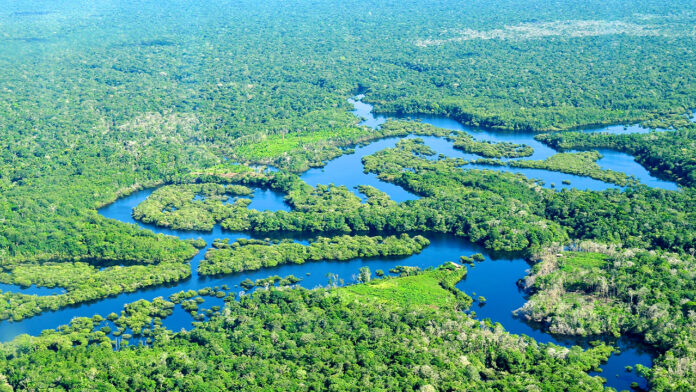The Amazon Rainforest, often referred to as the “lungs of the Earth,” stands as a vibrant and critical ecosystem teeming with life. In this article, we embark on a journey into the heart of this green jewel, uncovering fascinating facts about its biodiversity, indigenous cultures, environmental importance, and the challenges it faces in the modern world.
Biodiversity in the Amazon
Unparalleled Species Richness: The Amazon Rainforest is home to an astonishing array of plant and animal species. It is estimated that 10% of the world’s known species inhabit this dense forest, making it one of the most biodiverse places on the planet.
Hidden Wonders: From elusive jaguars and vibrant poison dart frogs to rare orchids and towering kapok trees, the Amazon’s biodiversity is a testament to the intricate web of life sustained within its lush canopy.
Indigenous Cultures
Diverse Indigenous Communities: The Amazon is not only a biological treasure trove but also a cultural mosaic. Numerous indigenous communities, each with unique languages, traditions, and knowledge of the rainforest, have thrived in harmony with their surroundings for centuries.
Sustainable Living Practices: Indigenous tribes in the Amazon have developed sustainable living practices that align with the natural rhythms of the rainforest. From agroforestry to traditional medicine, their deep connection to the land is a model for coexistence.
Environmental Significance
Oxygen Production: Often dubbed the “lungs of the Earth,” the Amazon Rainforest plays a crucial role in producing oxygen. The vast expanse of trees absorbs carbon dioxide and releases oxygen, contributing significantly to the planet’s respiratory balance.
Climate Regulation: Beyond oxygen production, the Amazon acts as a giant climate regulator. The transpiration process, where trees release water vapor, influences regional and global weather patterns, playing a key role in the Earth’s climate system.
The Mighty Amazon River
Lifeline of the Rainforest: The Amazon River, the second-longest river in the world, weaves through the heart of the rainforest. Its intricate network of tributaries sustains a rich aquatic ecosystem and serves as a vital resource for countless species.
Biodiversity Hotspots: The Amazon River and its tributaries are home to diverse aquatic life, including unique fish species, river dolphins, and migratory birds. These waterways are biodiversity hotspots that complement the richness of the rainforest.
Deforestation Challenges
Threats to Biodiversity: Despite its ecological importance, the Amazon Rainforest faces severe threats from deforestation. Human activities such as logging, agriculture, and infrastructure development contribute to the loss of habitat and biodiversity.
Impact on Climate Change: The ongoing deforestation in the Amazon not only endangers countless species but also exacerbates climate change. The release of stored carbon in trees contributes to greenhouse gas emissions, impacting global climate patterns.
Conservation Efforts
Protected Areas and Reserves: Conservation initiatives aim to protect the Amazon’s biodiversity. Establishing national parks, reserves, and indigenous territories helps preserve critical habitats and provides a foundation for sustainable management.
Sustainable Practices: Embracing sustainable practices, such as agroforestry and eco-friendly tourism, offers alternatives to destructive activities. Supporting local communities in sustainable ventures ensures the Amazon’s resources are managed responsibly.
Ecotourism in the Amazon
Experiencing the Rainforest: Responsible ecotourism provides a unique opportunity for visitors to experience the wonders of the Amazon while contributing to conservation efforts. Guided tours, wildlife observation, and community-based initiatives promote awareness and sustainability.
Balancing Conservation and Exploration: Striking a balance between ecotourism and conservation is crucial. Proper guidelines and regulations ensure that visitors appreciate the rainforest’s beauty without causing harm to its delicate ecosystems.
The Call for Global Action
International Collaboration: Preserving the Amazon requires global cooperation. International efforts to address deforestation, support sustainable development, and uphold indigenous rights are essential for safeguarding this invaluable ecosystem.
Advocacy and Awareness: Advocacy and raising awareness about the Amazon’s significance are crucial components of the global conservation effort. Education empowers individuals to make informed choices that contribute to the rainforest’s preservation.
Conclusion: Guardians of the Green Realm
In conclusion, the Amazon Rainforest stands as a testament to the wonders of nature, biodiversity, and the interconnectedness of life on Earth. From its vibrant flora and fauna to the diverse cultures that call it home, the Amazon is a reservoir of life that deserves our protection and respect. As we navigate the challenges of deforestation, climate change, and sustainable development, the collective responsibility to be guardians of the green realm becomes ever more vital. By understanding, appreciating, and actively participating in the conservation of the Amazon Rainforest, we ensure its enduring legacy for generations to come.

